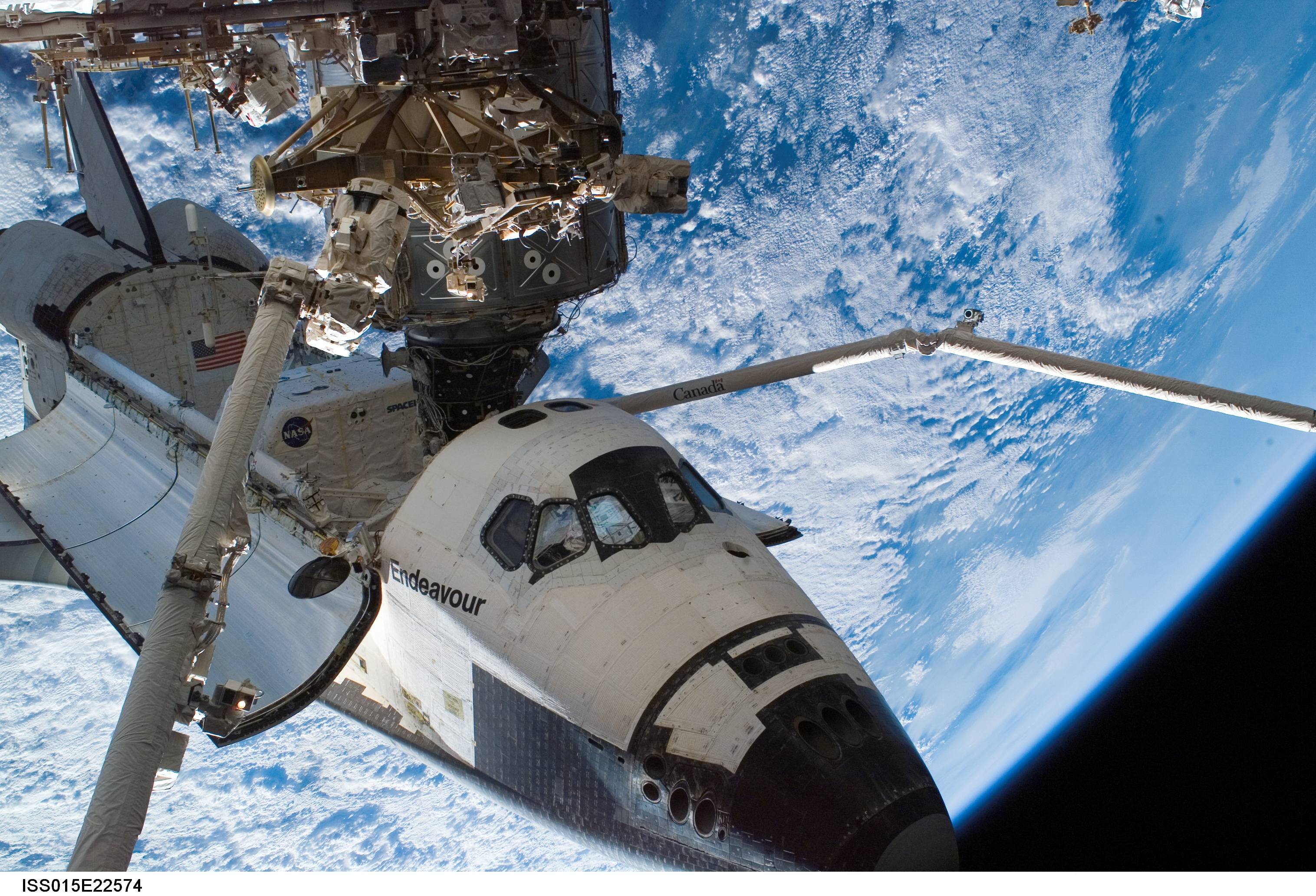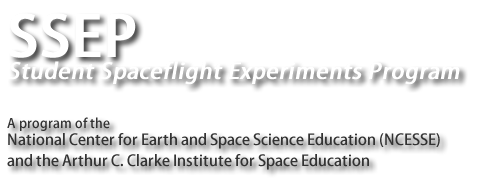A New U.S. National STEM Initiative for Grades 5-14
to inspire the next generation
of America’s scientists and engineers
Selected News Items from the SSEP National Blog—
5/27/11: Selection of SSEP Flight Experiments for Final Space Shuttle Flight Go to Post
5/27/11: NASA’s International Space Station Program Office Showcases SSEP Go to Post
5/16/11: Endeavour Blasts off with Aspirations of Thousands of Student Scientists Go to Post
4/27/11: Student Spaceflight Experiments Program is featured by NASA at nasa.gov Go to Post
4/27/11: Live Coverage of SSEP on the Final Flight of Endeavour Go to Post
For more news, Jump to the National Blog
Subscribe to the SSEP National Blog to receive email notification of breaking SSEP News.
Use the Subscribe Box at the bottom of the right column.
Watch: Video Clip describing SSEP
Download: 2-page Program Overview (MS Word)
 The Student Spaceflight Experiments Program (SSEP), launched June 2010 by the National Center for Earth and Space Science Education in partnership with NanoRacks, LLC, is a remarkable U.S. national Science, Technology, Engineering, and Mathematics (STEM) education initiative that gives up to 3,200 students across a community—middle and high school students (grades 5-12), and/or undergraduates at 2-year community colleges (grades 13-14)—the ability to design and propose real experiments to fly in low Earth orbit, first aboard the final flights of the Space Shuttle, and then on the International Space Station.
The Student Spaceflight Experiments Program (SSEP), launched June 2010 by the National Center for Earth and Space Science Education in partnership with NanoRacks, LLC, is a remarkable U.S. national Science, Technology, Engineering, and Mathematics (STEM) education initiative that gives up to 3,200 students across a community—middle and high school students (grades 5-12), and/or undergraduates at 2-year community colleges (grades 13-14)—the ability to design and propose real experiments to fly in low Earth orbit, first aboard the final flights of the Space Shuttle, and then on the International Space Station.
|
Click on the image and feel the magic. Endeavour in |
SSEP is about immersing and engaging
students and their teachers in real science
—on the high frontier—so that students
are given the chance to be scientists
—and experience science firsthand.
More broadly, SSEP is about a commitment to student ownership in exploration, to science as journey, and to the joys of learning. For school districts—even individual schools—it provides an opportunity to implement a systemic, high caliber, and historic STEM education program tailored to community need.
Each community participating in SSEP conducts a local Flight Experiment Design Competition with student teams vying for an experiment slot reserved just for their community in a real research mini-laboratory scheduled to fly in low Earth orbit. Your design competition—from program start, to experiment design, to submission of proposals by your student teams—runs a minimum of 8.5 weeks. Students can design experiments in diverse fields, including: seed germination, crystal growth, physiology of microorganisms and life cycles (e.g. bacteria), cell biology and growth, food studies, and studies of micro-aquatic life (e.g., Planaria Worms). Content resources for teachers and students support foundational instruction on science in microgravity and experimental design. A suite of SSEP program elements—the Community Program—leverages the flight experiment design competition to engage the entire community, embracing a Learning Community Model for STEM education, and allows the experience to be celebrated with national, even global audiences.
SSEP is the first pre-college STEM education program that is both a U.S. national initiative and implemented as an on-orbit commercial space venture. SSEP is enabled through NanoRacks LLC, which is working in partnership with NASA under a Space Act Agreement as part of the utilization of the International Space Station as a National Laboratory.
Current Opportunities
1. In Progress: Student Experiments on STS-134 the Final Flight of Shuttle Endeavour, scheduled for liftoff April 29, 2011
As a result of the first SSEP Announcement of Opportunity in June 2010, 16 communities across the U.S. joined the program, providing 20,000 grade 5-12 students the opportunity to participate. Student teams submitted 447 proposals, from which 16 were selected—one for each community. Visit the SSEP Community Network Hubsite for the list of winning proposals, profiles of the participating communities, the SSEP In the News page, and thoughts on program impact from students, teachers, and administrators on the In Our Own Words page. When reading descriptions of the proposals, one cannot help but be amazed at the remarkable things students in grades 5-12 can accomplish if given the chance.
2. New Announcement of Opportunity (December 22, 2010): Student Experiments on Proposed Final Flight of Shuttle Atlantis (STS-135), and Final Flight of U.S. Space Shuttle Program Is Your Community Ready to Participate?
The National Center for Earth and Space Science Education is now announcing a Student Spaceflight Experiments Program opportunity for STS-135. On January 20, 2011, NASA formally added STS-135 to its flight schedule. The STS-135 opportunity is available to school districts across the U.S., and has been expanded to include U.S. 2-year community colleges. This second SSEP opportunity also includes expansion internationally, with invitations to school districts across Canada. The Center expects that up to 50 communities will participate, engaging 100,000 grade 5-14 students in this historic adventure. Communities in the U.S. and Canada are invited to participate, and should begin the program by March 21, 2011.
Program Basics
SSEP provides significant flexibility for a community to design a program to their strategic needs in STEM education—
- A community of any size can participate, including a small school district, an individual school, a large inner city or suburban district, or a cluster of rural districts
- The baseline program provides for up to 3,200 students to participate in the design competition in each community, with the ability to customize a program for larger participation
- A community can open the competition to any grade level(s) in the grade 5-14 range, and engage wider audiences (all grade levels, families, and the general public) through the SSEP Community Program. This includes the potential for a National Team of scientists and engineers to travel to the community for up to a week, and engage thousands of grade K-14 students—one classroom at a time; conduct family and public programs like those the Center conducts at the Smithsonian’s National Air and Space Museum; and provide professional development for grade K-14 teachers.
- SSEP is a bold new commercial space venture in partnership with NanoRacks LLC. The National Center for Earth and Space Science Education, a 501(c)(3) non-profit, must recover the actual costs for the program (lease of mini-lab, flight integration services, program delivery and support), but also recognizes the significant challenge to a community in securing underwriting in the current financial climate. To this end, the Center committed significant development resources for the STS-134 opportunity and identified funding sources on behalf of 11 of the 16 participating communities. The Center is committed to help find underwriting for all communities interested in the STS-135 opportunity. If you are interested in this program, let us help.
Vision
SSEP was designed to be a keystone initiative for U.S. National STEM education, and to help inspire America’s next generation of scientists and engineers. Through the soon-to-be-announced international arm of the National Center for Earth and Space Science Education, SSEP participation is being expanded to Canada with the new STS-135 opportunity, and to the International Space Station partner nations through a later announcement of opportunity.
We want SSEP to provide routine student access to space via commercial payloads, and to leverage the power of such access into a STEM education program delivered across an entire school district, and serving a network of such communities across the nation—even internationally.
Phase 1 of the program is a unique and historic opportunity for students to propose experiments to fly aboard STS-134 and STS-135, the final flights of the Space Shuttle. We want the final voyages of the Space Shuttle to also mark a new beginning for private sector sponsored student experiments in space, which organizations on the SSEP Team have pioneered. The flight of Endeavour, and if approved, Atlantis, will be used as a gateway to Phase 2 of the SSEP—sustainable, ongoing access to space for grade 5-14 students inspired to propose experiments for low Earth orbit aboard the International Space Station, with transport aboard the NanoRacks manifest of cargo ships after the Space Shuttle era comes to a close.
To our children, who are America’s future in the 21st century—
be part of history … by making history.
To schools and school districts committed to STEM education—
together let’s help your students step into the shoes of scientists and engineers … right now.
PLEASE SHARE THIS WITH SCHOOL DISTRICT SUPERINTENDENTS, DISTRICT SCIENCE OFFICES, PRINCIPALS, AND TEACHERS
NEXT STEP: go to the About SSEP page for a comprehensive overview of SSEP, including a description of strategic STEM objectives, program elements, customization to community need, and cost.
SSEP is undertaken by the National Center for Earth and Space Science Education (NCESSE), a project of the 501(c)(3) Tides Center, in partnership with NanoRacks LLC. This on-orbit, real research opportunity for students is enabled through NanoRacks LLC, which is working in partnership with NASA under a Space Act Agreement as part of the utilization of the International Space Station as a National Laboratory.
All content on this website is Copyright 2011, National Center for Earth and Space Science Education (NCESSE). Any use of this content without the permission of NCESSE is prohibited.
